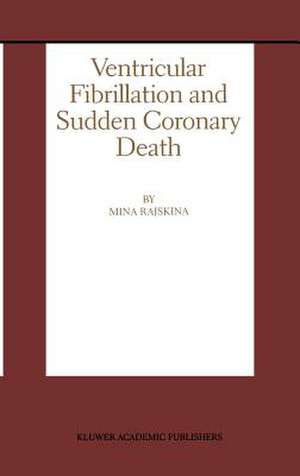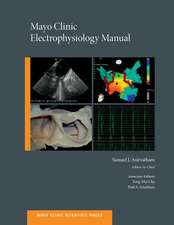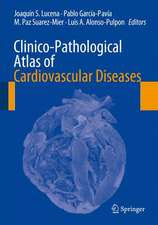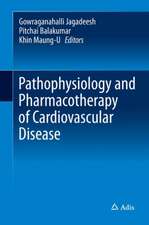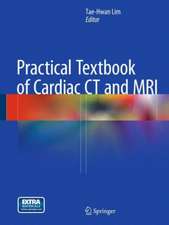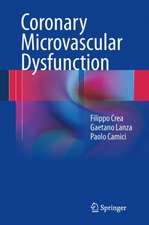Ventricular Fibrillation and Sudden Coronary Death: Developments in Cardiovascular Medicine, cartea 219
Autor Mina Rajskinaen Limba Engleză Hardback – 31 aug 1999
| Toate formatele și edițiile | Preț | Express |
|---|---|---|
| Paperback (1) | 1406.58 lei 6-8 săpt. | |
| Springer Us – 4 oct 2012 | 1406.58 lei 6-8 săpt. | |
| Hardback (1) | 1413.72 lei 6-8 săpt. | |
| Springer Us – 31 aug 1999 | 1413.72 lei 6-8 săpt. |
Din seria Developments in Cardiovascular Medicine
- 5%
 Preț: 1484.53 lei
Preț: 1484.53 lei - 5%
 Preț: 375.17 lei
Preț: 375.17 lei - 5%
 Preț: 354.10 lei
Preț: 354.10 lei - 5%
 Preț: 1419.03 lei
Preț: 1419.03 lei - 5%
 Preț: 376.43 lei
Preț: 376.43 lei - 5%
 Preț: 1098.27 lei
Preț: 1098.27 lei - 5%
 Preț: 1438.38 lei
Preț: 1438.38 lei - 5%
 Preț: 376.78 lei
Preț: 376.78 lei - 5%
 Preț: 368.37 lei
Preț: 368.37 lei - 5%
 Preț: 380.25 lei
Preț: 380.25 lei - 5%
 Preț: 2117.58 lei
Preț: 2117.58 lei - 5%
 Preț: 367.28 lei
Preț: 367.28 lei - 5%
 Preț: 366.56 lei
Preț: 366.56 lei - 5%
 Preț: 371.10 lei
Preț: 371.10 lei - 5%
 Preț: 370.94 lei
Preț: 370.94 lei - 5%
 Preț: 783.18 lei
Preț: 783.18 lei - 5%
 Preț: 713.18 lei
Preț: 713.18 lei - 5%
 Preț: 1098.27 lei
Preț: 1098.27 lei - 5%
 Preț: 375.49 lei
Preț: 375.49 lei - 5%
 Preț: 373.47 lei
Preț: 373.47 lei - 5%
 Preț: 723.93 lei
Preț: 723.93 lei - 5%
 Preț: 1104.13 lei
Preț: 1104.13 lei - 5%
 Preț: 2117.20 lei
Preț: 2117.20 lei - 5%
 Preț: 716.09 lei
Preț: 716.09 lei - 5%
 Preț: 372.03 lei
Preț: 372.03 lei - 5%
 Preț: 722.33 lei
Preț: 722.33 lei - 5%
 Preț: 660.07 lei
Preț: 660.07 lei - 5%
 Preț: 375.34 lei
Preț: 375.34 lei - 5%
 Preț: 1423.22 lei
Preț: 1423.22 lei - 5%
 Preț: 715.35 lei
Preț: 715.35 lei - 5%
 Preț: 790.69 lei
Preț: 790.69 lei - 5%
 Preț: 720.68 lei
Preț: 720.68 lei - 5%
 Preț: 3185.49 lei
Preț: 3185.49 lei - 5%
 Preț: 1418.27 lei
Preț: 1418.27 lei - 5%
 Preț: 784.64 lei
Preț: 784.64 lei - 5%
 Preț: 714.63 lei
Preț: 714.63 lei - 5%
 Preț: 370.74 lei
Preț: 370.74 lei - 5%
 Preț: 376.22 lei
Preț: 376.22 lei - 5%
 Preț: 660.85 lei
Preț: 660.85 lei - 5%
 Preț: 368.37 lei
Preț: 368.37 lei
Preț: 1413.72 lei
Preț vechi: 1488.12 lei
-5% Nou
Puncte Express: 2121
Preț estimativ în valută:
270.52€ • 289.27$ • 225.55£
270.52€ • 289.27$ • 225.55£
Carte tipărită la comandă
Livrare economică 17 aprilie-01 mai
Preluare comenzi: 021 569.72.76
Specificații
ISBN-13: 9780792385707
ISBN-10: 0792385705
Pagini: 213
Ilustrații: XXII, 213 p.
Dimensiuni: 155 x 235 x 14 mm
Greutate: 0.52 kg
Ediția:1999
Editura: Springer Us
Colecția Springer
Seria Developments in Cardiovascular Medicine
Locul publicării:New York, NY, United States
ISBN-10: 0792385705
Pagini: 213
Ilustrații: XXII, 213 p.
Dimensiuni: 155 x 235 x 14 mm
Greutate: 0.52 kg
Ediția:1999
Editura: Springer Us
Colecția Springer
Seria Developments in Cardiovascular Medicine
Locul publicării:New York, NY, United States
Public țintă
ResearchCuprins
1. The Ventricular Fibrillation and Heart’s Blood Supply.- 1.1 The types of cardiac blood supply.- 1.2 Hemodynamic changes.- 1.3 Collateral blood supply of the heart.- 1.4 The size of the ischemie zone.- 1.5 Po2 in the ischemie zone.- 1.6 Conclusion.- 2. Ventricular Fibrillation and Electrophysiological Changes.- 2.1 Role of the VPB in the onset of VF after CAO.- 2.2 Role of ionic current, membrane potentials, automatism, excitability, and conductivity changes in the appearance of VF after CAO.- 2.3 Study of mechanisms of ventricular arrhythmia using mathematical modeling and computer simulation.- 2.4 Conclusions.- 3. Ventricular Fibrillation and Changes in Metabolism of the Heart after Local Ischemia.- 3.1 Ischemic changes in the ox-red equilibrium.- 3.2 Ischemic disturbances in acid-base equilibrium.- 3.3 Ischemic disturbances in ion equilibrium.- 3.4 Conclusion.- 4. Role of the Sympathoadrenal System in the Appearance of Ventricular Fibrillation after Coronary Artery Occlusion.- 4.1 Afferent cardiac nerve activity and ventricular fibrillation after coronary artery occlusion.- 4.2 Afferent activity of the aortal nerve after CAO.- 4.3 Catecholamine balance in the heart and ventricular fibrillation after coronary artery occlusion.- 4.4 Conclusions.- 5. Role of Adrenaline in the Mechanisms of Ventricular Fibrillation Onset after Occlusion of Coronary Artery.- 5.1 Effect of adrenaline on the ox-red equilibrium of the heart.- 5.2 Effect of adrenaline on the acid-base equilibrium.- 5.3 Effect of adrenaline on ionic equilibrium.- 5.4 Influence of adrenaline on the heart’s electrophysiological processes.- 5.5 The comparison of the effects of arrhythmic and non- arrhythmic doses of adrenaline on a metabolism.- 5.6 Comparison of the effects of coronary artery occlusion andadrenaline on metabolism and electrophysiological processes in the heart.- 6. The Prevention of Ventricular Fibrillation after Coronary Artery Occlusion.- 6.1 The main directions of the antifibrillatory influences.- 6.2 Method of computer control of the use of antifibrillatory substances.- 6.3 The methods of prognostication of ventricular fibrillation.- 6.4 Evaluation of effectiveness of antifibrillatory influences.- 6.5 Conclusions.- 7. Mechanism of Ventricular Fibrillation Onset After Coronary Artery Occlusion.- 7.1 Electrophysiological hypotheses of ventricular fibrillation mechanism.- 7.2 Metabolic hypotheses of ventricular fibrillation.- 7.3 Neurohumoral hypotheses of ventricular fibrillation.- 7.4 Author’s hypothesis based on the systemic approach to study of ventricular fibrillation mechanisms.- 7.5 Ventricular fibrillation as a result of adrenal overcompensation.- Implications.- References.
